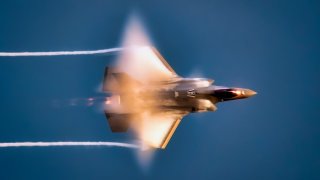Time to Sell the F-35 Fighter to India
The U.S. should reconsider its restrictions and sell the F-35 to India, strengthening an ally against China and reducing India's reliance on Russian technology.
Summary and Key Points: India, the world's largest democracy and fifth-largest economy, faces threats from belligerent China and nuclear-armed Pakistan. Its military modernization includes developing a fifth-generation warplane, but indigenous efforts have been slow. India prefers the U.S. F-35 but is hindered by its purchase of Russian S-400 systems, leading to the potential acquisition of the Russian Su-57.

-The U.S. should reconsider its restrictions and sell the F-35 to India, strengthening an ally against China and reducing India's reliance on Russian technology.
-India is one of the fastest-rising powers in the international system. It is the largest democracy in the world. The country has a fecund population, contributing to its rise, and India is the fifth-largest economy in the world in GDP terms.
India's Quest for Fifth-Gen Fighters: The F-35 vs. Su-57 Debate
But India sits in a rough neighborhood.
To its north lies an increasingly belligerent China. To its northwest sits nuclear-armed, Islamist-friendly Pakistan. What’s more, because of India’s growing economy and rising strength, with the aforementioned military threats of China and Pakistan in mind, New Delhi has been on a military modernization spree.
In fact, for a period of time, India was moving close to the United States and its alliance structure as a counterweight to China’s rise.
The Forever Changing Face of War
That, sadly, has ended (along with so many wonderful things) with the eruption of the Ukraine War. Once the Russian tanks rolled into Ukraine, the Americans and their NATO allies sanctioned everything Russian. It shouldn’t surprise anyone that Washington quickly directed its ire to rising India due to the fact that New Delhi, unlike Berlin and the other European members of NATO, was not blindly following the Biden administration’s policies opposing Russia.
There’s been a noticeable cooling of Indo-American relations as a result. India as a rising economy in a tough neighborhood has certain needs that cannot be ignored. One of those needs is reliable access to relatively cheap energy sources. This is something that Russia is more than happy to provide.
Further, so much of India’s military is enmeshed with the Russians, and has been since the 1940s, that the notion New Delhi could just abandon Russia because of their actions in Ukraine was laughable.

India’s relationship with Russia is complex.
Yes, it involves a heavy reliance on Russian-built weapons and support. But that’s because, after India gained its independence from Britain, the Indian leadership never again wanted India to become dependent on any foreign power – least of all Western power. After decolonization, India flirted with Communism and found an ally in the Soviet Union. Not only were they ideologically aligned, but the USSR had successfully convinced many people in the Global South that the Soviets were, in fact, liberating ant-colonialists.
Once heavily enmeshed in the old Soviet sphere, it became difficult for future leaders to divorce or distance India from Russia. The rise of a hostile China right alongside India’s northern border, though, was enough to get India to start looking more to the United States.
Slowly but surely, India had started to reposition itself closer to the United States. But the Americans were never satisfied with the speed of India’s conversion.
India Wants a New Warplane
As part of their military modernization program, New Delhi wants to develop a fifth-generation warplane. India’s military has been developing its own indigenously produced fifth-generation plan. But the going has been slow, and critical gaps are forming. There is a sense of urgency, too, because China now has a fifth-generation warplane, the J-20, that should not be underestimated.
To plug the gaps in India’s air warfare capabilities, discussions have shifted to purchasing an existing, foreign fifth-generation fighter. New Delhi would prefer to acquire the F-35 Lightning II warplane from the United States. Sadly, this fifth-generation wonder is off-limits to the Indians because New Delhi has purchased Russian-built S-400 air defense systems. Thus, America’s odd rules governing the export of its F-35 warplane have negated what could have been an incredible opportunity to slowly move India out of Russia’s camp.

Instead, the Indians are looking to purchase the Russian-built Su-57. Washington should immediately waive all reservations about India’s relationship with Russia and start selling them the weapons and platforms they need to remain dominant in their region. It is obscene that such a useful ally against America’s biggest enemy, China, would be sidelined and denied access to Western technology because of its ties to Russia. It’s the hallmark of a nation being run by children who happen to inhabit the body of an adult.
The F-35 should immediately be sold to India to allow for them to better defend their land and to prepare for the inevitable clash with China. If India purchases the Su-57 from Russia because it’s easier to obtain, then the Americans will likely have dealt themselves a critical blow. The U.S. government should be doing everything in its power to ensure India gets the systems it requires, and that those systems be American.
Author Experience and Expertise: Brandon J. Weichert
Brandon J. Weichert, a National Interest national security analyst, is a former Congressional staffer and geopolitical analyst who is a contributor at The Washington Times, the Asia Times, and The-Pipeline. He is the author of Winning Space: How America Remains a Superpower, Biohacked: China’s Race to Control Life, and The Shadow War: Iran’s Quest for Supremacy. His next book, A Disaster of Our Own Making: How the West Lost Ukraine, is due October 22 from Encounter Books. Weichert can be followed via Twitter @WeTheBrandon.
All images are Creative Commons.


